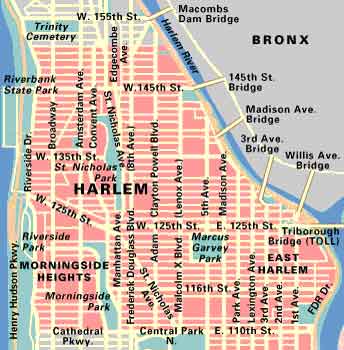 | |
Harlem Visitor Information Kiosk Adam Clayton Powell State Office Building plaza, 163 West 125th Street, just east of Adam Clayton Powell, Jr. Boulevard (Seventh Avenue) Open seven days a week Hours: Monday-Friday 9am-6pm; Saturday-Sunday 10am-6pm. Directions by Subway: A, B, C, D or 2,3 to 125th Street Uptown Culture Harlem's main thoroughfare is 125th Street. The Apollo Theatre, a concert venue for luminaries as well as a rite of passage for rising musicians, is on 125th Street. Count Basie, Bessie Smith, Nat King Cole, Marvin Gaye, Sammy Davis, Jr., and Aretha Franklin have all played here and past winners of its weekly, wild and crazy amateur night include Billie Holiday, Ella Fitzgerald, Sarah Vaughn, and the Jackson Five. The Studio Museum of Harlem is one of the community's showplaces, housing a large collection of sculpture, paintings, and photographs and specializing in African American artists and artists of African descent. The Schomburg Center for Research in Black Culture (part of the New York Public Library's Division of Negro History) on Lenox Avenue, is an eye-popping literary treasure trove, comprising more than 5,000,000 books, documents, and photographs recording black history and more than 400 Black newspapers and 1,000 periodicals from around the world. The Harlem Week/Harlem Jazz & Music Festival is an annual summer festival taking place each August, with food tasting, art exhibits, concerts, seminars, music, street entertainment, sporting events, and an auto show. And don't miss the The Greater Harlem Historic Bike Tour in early August. The Urban World Film Festival takes place in August every year. Things To Do and See As Langston Hughes put it, "there is so much to see in Harlem," and among other wonderful things to explore here are Hamilton Grange, the country estate of Alexander Hamilton; Riverbank State Park, with its wonderful carousel and a spectacular view of the George Washington Bridge; the beautiful architecture of City College (CUNY); the lovely row houses of Hamilton Heights (often called Sugar Hill) that have been home to Count Basie, Chief Justice Thurgood Marshall, and boxing great Sugar Ray Robinson; and Striver's Row (a reference to the upward mobility of the doctors, lawyers and other middle-class professionals who purchased homes here) on 138th and 139th Streets, an elegant row of early 20th-century town houses designed by famous period architects such as Sanford White. Map © David Lindroth Inc., dlindmap@bellatlantic.net All rights reserved. |
